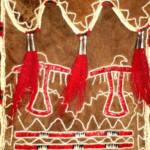My son and I were wading in a small river and catching fish when we came to a log that had fallen across the stream. As we were catching fish, not just fishing (which to me means ‘trying’ to catch fish), we were in a hurry to get around the log and back to the water. As we scurried up the bank and around the log, something caught my eye. I grabbed the rock and stuck it into my pocket and kept moving. A few hours later we were in the car when I remember the odd rock. I pulled it out of my pocket and realized it was not a natural curiosity.
The flat, round rock had a hole in the center of it, not perfectly drilled like a machine, and not broken out from natural disturbance. I theorized that the rock was used by native peoples to weight down fishing nets, but I have seen similar items that were used to weight spears either for gigging (stabbing) fish or to dig into the ground.
On that day my interest in looking for Native American artifacts was reborn. As a kid I used to spend considerable time fishing in a small stream and skipping rocks. I suppose in a normal summer I would find 5 or 6 arrowheads on the banks of that small stream. In the last few years since finding the rock with a hole in it I have found numerous other implements. While I am certainly an amateur and basically only search for artifacts while hunting or fishing here are some tips that I have picked up along the way.
The first thing to do is to make certain you have permission to be on the land and are allowed to collect artifacts where you are. Most public land prohibits this activity. In case any policy makers read this I’ll get on my soap box now. While certainly no one wants picks and shovels destroying the scenic beauty of our public land, why can you not collect what is laying around? If left in nature they simply will become broken, lost, and forgotten. Public policy should encourage the artifacts to be found and returned to the state. If given recognition most people would return the item. Put the pieces in a museum with a note stating who found it and give that person a certificate thanking them for supporting our cultural heritage.
You need to familiarize yourself with the culture of the native peoples of your area. This will give you valuable information where to look. It is likely that certain areas will be known locally for Native American habitation or activity. Areas where stone could be gathered near water are ideal locations. All native peoples needed stone for tools and water to drink and fish.
Like all outdoor activities the best time to look for artifacts is anytime that you can. That being said some times are better than others. My favorite time is during a drought. As many activities were based around water, many artifacts are found in the water. During a drought water levels are reduced exposing areas to the naked eye that can not normally be seen. In addition to historic items I have found many coins, watches, and pocket knives doing this. Another good time is after a flood. The flooded waters churn the rocks and soil and uncover previously unexposed items.
When searching look for unnatural shapes, perfect circles, sharp corners, and rows of markings that are not usually made by natural forces. Get out their and look, you may be surprised what you find.




